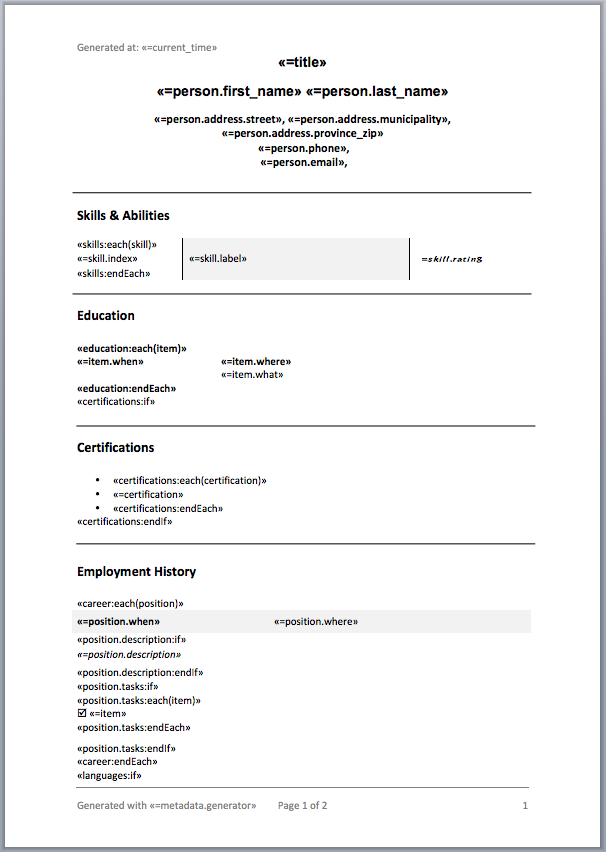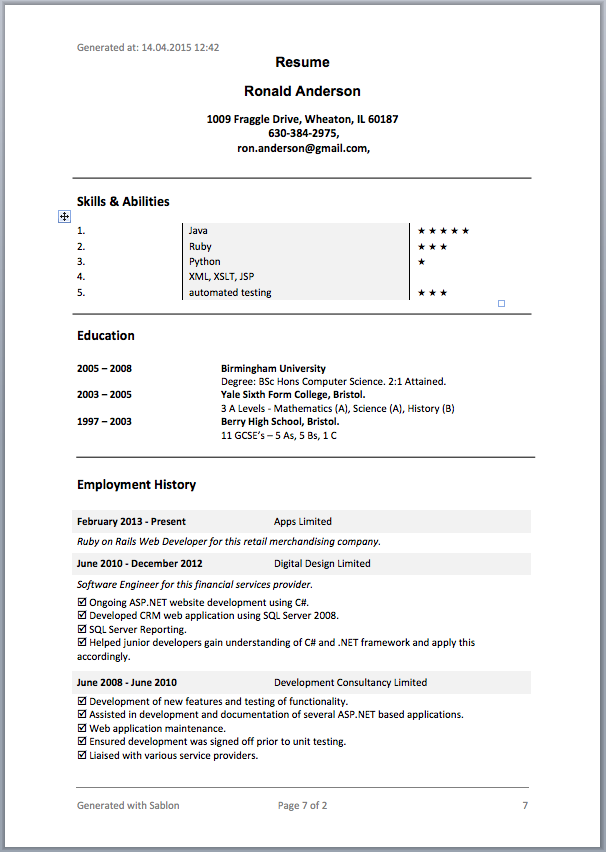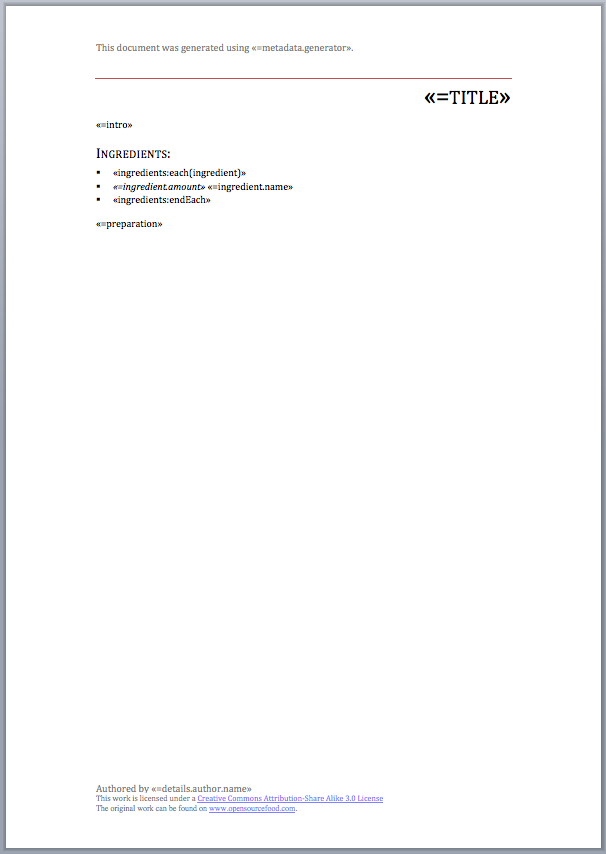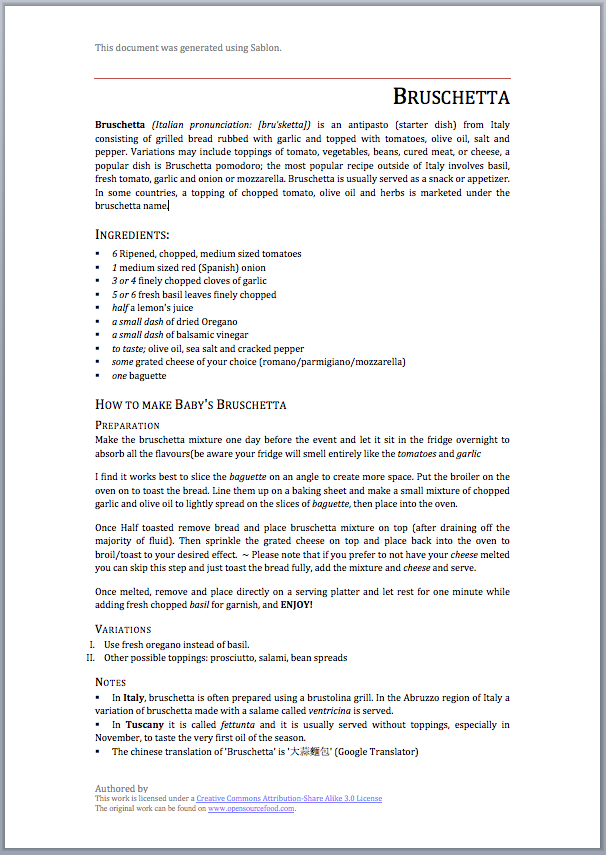Is a document template processor for Word docx files. It leverages Word's
built-in formatting and layouting capabilities to make template creation easy
and efficient.
Note: Sablon is still in early development. Please report if you encounter any issues along the way.
Add this line to your application's Gemfile:
gem 'sablon'require "sablon"
template = Sablon.template(File.expand_path("~/Desktop/template.docx"))
context = {
title: "Fabulous Document",
technologies: ["Ruby", "Markdown", "ODF"]
}
template.render_to_file File.expand_path("~/Desktop/output.docx"), contextSablon templates are normal Word documents (.docx) sprinkled with MailMerge fields
to perform operations. The following section uses the notation «=title» to
refer to Word MailMerge fields.
The most basic operation is to insert content. The contents of a context variable can be inserted using a field like:
«=title»
It's also possible to call a method on a context object using:
«=post.title»
NOTE: The dot operator can also be used to perform a hash lookup. This means that it's not possible to call methods on a hash instance. Sablon will always try to make a lookup instead.
This works for chained method calls and nested hash lookup as well:
«=buyer.address.street»
Generally Sablon tries to reuse the formatting defined in the template. However, there are situations where more fine grained control is needed. Imagine you need to insert a body of text containing different formats. If you can't decide the format ahead of processing time (in the template) you can insert WordProcessingML directly.
It's enough to use a simply insertion operation in the template:
«=long_description»
To insert WordProcessingML prepare the context accordingly:
word_processing_ml = <<-XML.gsub("\n", "")
<w:p>
<w:r w:rsidRPr="00B97C39">
<w:rPr>
<w:b />
</w:rPr>
<w:t>this is bold text</w:t>
</w:r>
</w:p>
XML
context = {
long_description: Sablon.content(:word_ml, word_processing_ml)
}
template.render_to_file File.expand_path("~/Desktop/output.docx"), contextIMPORTANT: This feature is very much experimental. Currently, the insertion will replace the containing paragraph. This means that other content in the same paragraph is discarded.
IMPORTANT: Markdown insertion has been deprecated in favor of HTML
insertion. For now the behavior is still packaged with sablon. Note that the
implementation of Sablon::Content::Markdown is already based on
Sablon::Content::HTML. Markdown insertion will be removed in the future.
Similar to WordProcessingML it's possible to use markdown while processing the tempalte. You don't need to modify your templates, a simple insertion operation is sufficient:
«=article.body»
To use Markdown insertion prepare the context like so:
markdown_body = <<-MD
This text can contain *additional formatting*
according to the **Markdown** specification.
MD
context = {
article: { body: Sablon.content(:markdown, markdown_body) }
}
template.render_to_file File.expand_path("~/Desktop/output.docx"), contextMarkdown insertion has built-in support for:
For headings and lists to function properly it is necessary that the template
defines specific styles. Headings use styles called Heading1, Heading2,
etc. according to the header level. Ordered lists will use the style
ListNumber and unordered lists use ListBullet. Nested lists are not
supported. Normal text paragraphs use the style Paragraph. It's not necessary
to have that style in the template. Word will fall back to using the Normal style.
IMPORTANT: This feature is very much experimental. Currently, the insertion will replace the containing paragraph. This means that other content in the same paragraph is discarded. In the near future this feature will most likely be implemented on top of HTML insertion.
Similar to WordProcessingML it's possible to use html as input while processing the tempalte. You don't need to modify your templates, a simple insertion operation is sufficient:
«=article.body»
To use HTML insertion prepare the context like so:
html_body = <<-HTML
<div>This text can contain <em>additional formatting</em>
according to the <strong>HTML</strong> specification.</div>
HTML
context = {
article: { html_body: Sablon.content(:html, html_body) }
}
template.render_to_file File.expand_path("~/Desktop/output.docx"), contextCurrently HTML insertion is very limited and strongly focused on the HTML generated by Trix editor.
IMPORTANT: This feature is very much experimental. Currently, the insertion will replace the containing paragraph. This means that other content in the same paragraph is discarded.
Sablon can render parts of the template conditonally based on the value of a context variable. Conditional fields are inserted around the content.
«technologies:if»
... arbitrary document markup ...
«technologies:endIf»
This will render the enclosed markup only if the expression is truthy.
Note that nil, false and [] are considered falsy. Everything else is
truthy.
For more complex conditionals you can use a predicate like so:
«body:if(present?)»
... arbitrary document markup ...
«body:endIf»
Loops repeat parts of the document.
«technologies:each(technology)»
... arbitrary document markup ...
... use `technology` to refer to the current item ...
«technologies:endEach»
Loops can be used to repeat table rows or list enumerations. The fields need to be placed in within table cells or enumeration items enclosing the rows or items to repeat. Have a look at the example template for more details.
It is possible to nest loops and conditionals.
Sometimes it's necessary to include markup in the template that should not be visible in the rendered output. For example when defining sample numbering styles for HTML insertion.
«comment»
... arbitrary document markup ...
«endComment»
The sablon executable can be used to process templates on the command-line.
The usage is as follows:
cat <context path>.json | sablon <template path> <output path>
If no <output path> is given, the document will be printed to stdout.
Have a look at this test for examples.
There is a sample template in the repository, which illustrates the functionality of sablon:
Processing this template with some sample data yields the following output document. For more details, check out this test case.
The executable test showcases the sablon
executable.
The template
is rendered using a json context to provide the data. Following is the resulting output:
- Fork it ( https://github.com/senny/sablon/fork )
- Create your feature branch (
git checkout -b my-new-feature) - Commit your changes (
git commit -am 'Add some feature') - Push to the branch (
git push origin my-new-feature) - Create a new Pull Request
These projects address a similar goal and inspired the work on Sablon:



